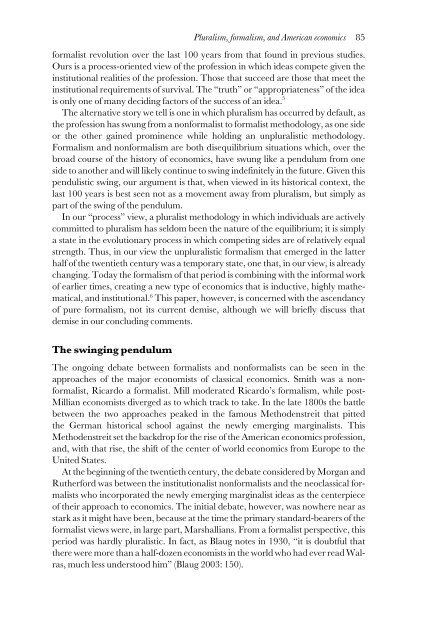Money and Markets: Essays in Honor of Leland B. Yeager
Money and Markets: Essays in Honor of Leland B. Yeager
Money and Markets: Essays in Honor of Leland B. Yeager
Create successful ePaper yourself
Turn your PDF publications into a flip-book with our unique Google optimized e-Paper software.
Pluralism, formalism, <strong>and</strong> American economics 85formalist revolution over the last 100 years from that found <strong>in</strong> previous studies.Ours is a process-oriented view <strong>of</strong> the pr<strong>of</strong>ession <strong>in</strong> which ideas compete given the<strong>in</strong>stitutional realities <strong>of</strong> the pr<strong>of</strong>ession. Those that succeed are those that meet the<strong>in</strong>stitutional requirements <strong>of</strong> survival. The “truth” or “appropriateness” <strong>of</strong> the ideais only one <strong>of</strong> many decid<strong>in</strong>g factors <strong>of</strong> the success <strong>of</strong> an idea. 5The alternative story we tell is one <strong>in</strong> which pluralism has occurred by default, asthe pr<strong>of</strong>ession has swung from a nonformalist to formalist methodology, as one sideor the other ga<strong>in</strong>ed prom<strong>in</strong>ence while hold<strong>in</strong>g an unpluralistic methodology.Formalism <strong>and</strong> nonformalism are both disequilibrium situations which, over thebroad course <strong>of</strong> the history <strong>of</strong> economics, have swung like a pendulum from oneside to another <strong>and</strong> will likely cont<strong>in</strong>ue to sw<strong>in</strong>g <strong>in</strong>def<strong>in</strong>itely <strong>in</strong> the future. Given thispendulistic sw<strong>in</strong>g, our argument is that, when viewed <strong>in</strong> its historical context, thelast 100 years is best seen not as a movement away from pluralism, but simply aspart <strong>of</strong> the sw<strong>in</strong>g <strong>of</strong> the pendulum.In our “process” view, a pluralist methodology <strong>in</strong> which <strong>in</strong>dividuals are activelycommitted to pluralism has seldom been the nature <strong>of</strong> the equilibrium; it is simplya state <strong>in</strong> the evolutionary process <strong>in</strong> which compet<strong>in</strong>g sides are <strong>of</strong> relatively equalstrength. Thus, <strong>in</strong> our view the unpluralistic formalism that emerged <strong>in</strong> the latterhalf <strong>of</strong> the twentieth century was a temporary state, one that, <strong>in</strong> our view, is alreadychang<strong>in</strong>g. Today the formalism <strong>of</strong> that period is comb<strong>in</strong><strong>in</strong>g with the <strong>in</strong>formal work<strong>of</strong> earlier times, creat<strong>in</strong>g a new type <strong>of</strong> economics that is <strong>in</strong>ductive, highly mathematical,<strong>and</strong> <strong>in</strong>stitutional. 6 This paper, however, is concerned with the ascendancy<strong>of</strong> pure formalism, not its current demise, although we will briefly discuss thatdemise <strong>in</strong> our conclud<strong>in</strong>g comments.The sw<strong>in</strong>g<strong>in</strong>g pendulumThe ongo<strong>in</strong>g debate between formalists <strong>and</strong> nonformalists can be seen <strong>in</strong> theapproaches <strong>of</strong> the major economists <strong>of</strong> classical economics. Smith was a nonformalist,Ricardo a formalist. Mill moderated Ricardo’s formalism, while post-Millian economists diverged as to which track to take. In the late 1800s the battlebetween the two approaches peaked <strong>in</strong> the famous Methodenstreit that pittedthe German historical school aga<strong>in</strong>st the newly emerg<strong>in</strong>g marg<strong>in</strong>alists. ThisMethodenstreit set the backdrop for the rise <strong>of</strong> the American economics pr<strong>of</strong>ession,<strong>and</strong>, with that rise, the shift <strong>of</strong> the center <strong>of</strong> world economics from Europe to theUnited States.At the beg<strong>in</strong>n<strong>in</strong>g <strong>of</strong> the twentieth century, the debate considered by Morgan <strong>and</strong>Rutherford was between the <strong>in</strong>stitutionalist nonformalists <strong>and</strong> the neoclassical formalistswho <strong>in</strong>corporated the newly emerg<strong>in</strong>g marg<strong>in</strong>alist ideas as the centerpiece<strong>of</strong> their approach to economics. The <strong>in</strong>itial debate, however, was nowhere near asstark as it might have been, because at the time the primary st<strong>and</strong>ard-bearers <strong>of</strong> theformalist views were, <strong>in</strong> large part, Marshallians. From a formalist perspective, thisperiod was hardly pluralistic. In fact, as Blaug notes <strong>in</strong> 1930, “it is doubtful thatthere were more than a half-dozen economists <strong>in</strong> the world who had ever read Walras,much less understood him” (Blaug 2003: 150).
















